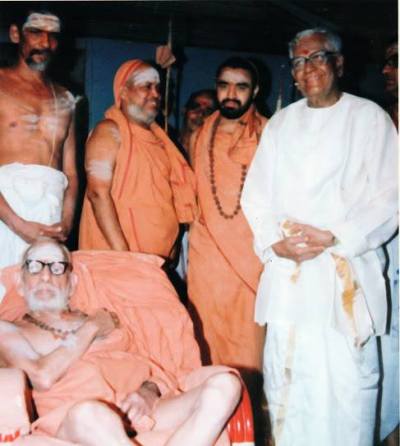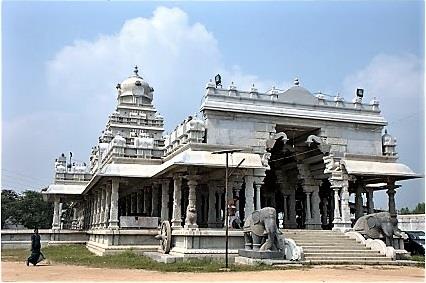Introduction
Every few generations, we humans have a tendency to forget our designated path and start to stray away from our Dharma. Every time, this happens an eminent philosopher or a sage appears on the scene to lead us back. Sri Mahaperiava of Kanchi is one such. He arrived at a time when Dharmic activities were at a low due to the influence of opportunistic elements. People were ashamed to follow their religious duties openly and many began to forego their spiritual values. The birth of Paramacharya was a great boon to all Aastikas. He played a major role in the re-establishment of Dharmic values in South India (and in the whole country).
Birth
Jagadguru Shri Chandrasekharendra Saraswati Mahaswamigal, also known as the Sage of Kanchi or Mahaperiyava was the 68th Shankaracharya of the Kanchi Kamakoti Peetham located in Tamil Nadu. He was born as Swaminathan on 20 May 1894. His father was Subrahmanya Sastri who worked as a teacher and his mother was Mahalakshmi. Swaminathan was the second child of his parents. His upanayanam was duly performed and he became well versed in the Vedas and started performing pujas.
Ascension to the Peetham
In 1906, the Sixty-sixth Acharya of Kamakoti Peetha, Sri Chandrasekharendra Saraswati VI, attained siddhi and Swaminathan’s maternal cousin was installed as the 67th Acharya. Due to strange turn of events, the 67th Acharya also passed away due to an illness within a few days of assuming the Peetham. As a result Swaminathan found himself installed as the Acharya. He ascended the Kanchi Kamakoti Peetham on the Tamil month of Maasi ( Paraabhava Year, 1907) as the 68th Acharya with the Sannyasa name Chandrasekharendra Saraswati. He was well trained in the Vedas, puranas, and ancient Indian literature. His tenure as Peetadhipathi for several decades is considered as the Golden age of Kanchi Mutt.
His Humility and Approachability
The Paramacharya became the guiding light for countless people. Not only was he well-versed in the scriptures and Shastras, but he was also able to gauge the mindset of the masses. Thus he was able to combine religious prescriptions and social reform which attracted numerous devotees. Several eminent dignitaries such as Prime Ministers, Presidents, film personalities, industrialists, philosophers etc became his disciples and visited him often to seek his blessings. Even so, the Acharya never attempted to perform miracles to prove his eminence. He always maintained that our Dharma is based on Vedas (Vaidika matam) and no human being is bigger than Dharma itself.
Throughout his life, he displayed humility, humour and a logical approach. Dr. Paul Brunton records his first impression of Paramacharya in his famous book A Search in Sacred India as follows:
“ .. That elusive element which the French aptly term “spiritual”, is present in the face. His expression is modest and mild, the large dark eyes being extraordinarily tranquil and beautiful. .. Such a face might have belonged to one of the saints who graced the Christian Church during the Middle Ages, except that this one possesses the added quality of intellectuality. .”.
Services to Mankind
Some of his unparalleled services to mankind are as follows:
- Revival of Vedas
The Acharya believed that the only way to protect our religion is through protecting the Vedas (Veda Samrakshanam). To this effect, he established mutts and patashalas in several places and ensured a steady cash flow for maintaining them. He encouraged young children to join Patashalas and enjoyed listening to their Vedic chanting. There is this one instance when the Acharya realised that the fourth Veda, Atharvana was gradually becoming extinct as there were not many practitioners. He immediately arranged for an Ad in newspaper and found a single person who was a practitioner. He ensured a couple of his disciples went and learnt Atharvana Veda from the practitioner and thus seeded the re-emergence of Atharvana Veda in South India. It is tough to imagine the state of Vedas today without the intervention of Paramacharya. - Simplification of rituals
Paramacharya encouraged everyone to undertake devotional practices and daily rituals such as performing pujas and recitations of Vedas and Slokas. He simplified Bhakti by encouraging people to do simple things such as to chant and write the Rama Nama. He popularised chanting of Vishnu Sahasranama which was also taken up several women. - Temple Renovations
On his initiative many neglected temples were renovated and new temples and prayer halls were erected. Thanks to the effort of Kanchi mutt, several temples got regular priests who could do regular pujas in those temples and were given a livelihood for their services. It is also believed that he played a major role in the opening of Kailash/Manasarovar pilgrimage of the Chinese Government for devotees from India. - Social reforms
Paramacharya was a strong believer of ‘Vasudhaiva Kutumbakam’ (the whole world is one single family) and considered every being as equal. He made radical social changes by allowing devotees inside the temple premises who were not allowed earlier. He also had devotees from other religions who were attracted to his persona and features. The interesting point to note is that he never wanted anyone to convert from their respective religions as according to him all religions lead to a single God – parabrahman. - His speeches
He travelled across the length and breadth of the country. On several occasions he addressed the people on various aspects of dharma, our rich heritage and a variety of similar subjects. He delivered these discourses on temple halls, river banks and sabhas which is a testament to his simplicity.
His Nationalism
Being a Sanyasi he didn’t have any political affiliation. However he provided his moral support for the freedom movement. He wanted our people to forego their foreign outlook and be proud of their rich culture. He preferred to wear Khadhi in support of Indian weavers. In fact, he even visualised the colours of the National flag as belonging to the three Devis – Lakshmi, Durga and Saraswati.
His Compassion
On one occasion, when Paramacharya was on the silent vow (mauna vratam) a group of blind children from a school happened to visit the Mutt. When the children came to know about the vow, they became upset on not being able to hear his voice. When the Acharya was briefed about this, he immediately broke his vow and spent the entire day with the children speaking to each one of them and blessing them. Asked about breaking his vow which is very rare for him, the Acharya replied “There is no Dharma bigger than compassion. Always remember that…”.
Association with Ramana Maharishi
Maha Periyava had known Sri Ramana Maharshi very well even without seeing him. The two sages never met each other but held deep respect for each other. Once, Paul Brunton the spiritual author from the West visited Paramacharya and asked for a Guru who could lead him to the eternal truth. Paramacharya advised him to see Bhagavan Ramana Maharshi at Tiruvannamalai. He knew that Sri Ramana alone could be most suited Guru for the Westerner. Once, a devotee went up to the Acharya and posed a question about whether he would meet Ramanar. To which Paramacharya replied, “When were we separate? Only if we were apart from each other, the question of meeting comes; but we were always one”.
His Quotes
Paramacharya composed the famous song ‘maitreem bhajata’ (‘cultivate friendship and humanity’) in Sanskrit which was sung by Smt. M.S. Subbulakshmi at the UN in 1966.
Here are some of his famous quotes extracted from his speeches:
On Religious Conversions
“All religions have one common ideal -worship of the lord, and all of them proclaim that there is but one god. The one god accepts your devotion irrespective of the manner of your worship, whether it is according to this or that religion. So there is no need to abandon the religion of your birth and embrace another.”
Character
“The decay of a religion in any country could be attributed to the lack of character of its leaders and of the people constituting the establishment responsible for its growth.”
On Vedas
“All sounds originate in space. From them arose creation. According to science, the cosmos was produced from the vibrations in space. By virtue of their austerities the sages had the gift of seeing the ‘mantras’ in space, the mantras that liberate men from this creation. .. The sages saw them and made a gift of them to the world. ““The Vedas are not only the source of the various divisions of Hinduism, all the religions of the world may be traced back to them. It is our bounden duty to preserve them for all time to come with their glory undiminished. “
God’s Gift to Us
“In His mercy the Lord gives us every time a fresh opportunity to wash away our sins. The Guru, the Sastras (scriptures) and the temples are his gifts to wipe away our inner impurities. “
Conclusion
The Paramacharya’s knowledge of the Shastras, Vedas, Vedanta etc. was unparalleled. He led an austere and simple life dedicated to the protection and establishment of the Dharma. He did not even swerve a little from the teachings of Adi Sankara and the tenets of Sanatana Dharma. His whole life was an example of how to live as per the principles of Dharma. Though he attained Mukthi on 8 January 1994 (just a few days before his centenary year) his teachings and discourses live on powering the lives of all followers of Sanatana Dharma.
To know more about such icons, please click here.


